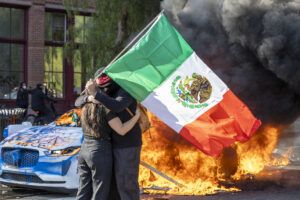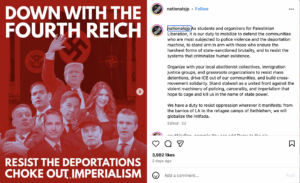On Friday, June 6, U.S. Immigration and Customs Enforcement (ICE) launched a series of coordinated raids across Los Angeles, detaining dozens of individuals accused of being in the United States illegally. The arrests—made at both workplaces and homes—sparked immediate backlash.
In the heavily Hispanic suburb of Paramount, where over 82 percent of residents identify as Latino, protests escalated quickly. Demonstrators hurled rocks and Molotov cocktails at law enforcement, who responded with pepper spray, rubber bullets, and smoke canisters. Within days, the unrest had spread to downtown Los Angeles. On June 10, city officials imposed a curfew from 8 p.m. to 6 a.m., and hundreds of arrests followed.
Similar protests emerged in other major cities—including New York, Chicago, Seattle, Denver, San Francisco, and Atlanta—though none matching the violence witnessed in LA.
The riots have dominated headlines across the U.S., fueling a national debate over immigration policy, the limits of federal authority, and the broader ambitions of the Trump administration’s security agenda.
But amid all this coverage, one detail has been quietly omitted—or perhaps deliberately brushed aside: the unmistakable role of pro-Palestinian activists in the riots. Not merely present—but masked, vocal, and often leading the charge in the most violent flashpoints.
Footage posted online shows rioters draped in keffiyehs and waving PLO flags as they attack police officers, torch cars and public property, and hurl Molotov cocktails.
One particularly disturbing video shows a crowd gathered on a highway overpass, waving a massive Palestinian flag and pelting police cruisers below with rocks—many in the crowd wearing the traditional Palestinian head covering.
In another image, a masked rioter wears a PFLP headband while hoisting a Mexican flag—a jarring emblem not of solidarity, but of how seamlessly the anti-Israel agenda has inserted itself into a protest about something else entirely.

Activist leaders have not exactly been subtle about their intentions. Groups like Students for Justice in Palestine, the Palestinian Youth Movement, PAL-Awda, Within Our Lifetime, and others have openly called on their followers to join the protests, framing the unrest as part of a broader campaign to “globalize the intifada.”
National SJP posted an image depicting Trump administration officials adorned with a swastika, labeling it “the Fourth Reich” and urging action. “We have a duty to resist oppression wherever it manifests: from the barrios of LA to the refugee camps of Bethlehem,” the group declared. “We will globalize the intifada.”

Isra Hirsi, daughter of anti-Israel congresswoman Ilhan Omar and recently suspended from Columbia University over her role in violent campus protests, posted on Instagram: “From L.A. to Rafah, there is one common oppressor. Death to the colonial empire. Life for our children.” She also shared a screenshot reading, in all caps: “FUCK ICE!”

She’s far from alone. Dozens of high-profile anti-Israel activists have used their platforms to encourage participation in the anti-ICE demonstrations.
And yet, in the pages of major newspapers and the broadcasts of primetime news, you’d be forgiven for thinking none of this ever happened. Mentions of the Palestinian flag are fleeting. The presence of anti-Israel groups is buried or ignored entirely. CNN’s Shimon Prokupecz offered perhaps the most honest nod to reality when he observed that “people are holding signs saying ‘ICE out of New York City.’ We’ve seen flags of Mexico, we’ve seen the Palestinian flag”—before quickly moving on.
Not one mainstream outlet has thought to investigate the deeper connections, to ask whether this is spontaneous grassroots outrage or something more orchestrated. Not one has paused to consider how a domestic protest about immigration raids morphed into yet another anti-Israel battleground.
Because to acknowledge the truth—that a significant faction of these riots is being driven by activists who endorse violence, call for an intifada, and seek to destroy Israel and dismantle the United States—would disrupt the media’s preferred narrative: that this is a righteous uprising of marginalized communities reacting to injustice. So they don’t.
Instead, they turn a blind eye, bury the lede, and pretend the keffiyehs, chants, and Molotov cocktails are just another expression of grassroots dissent.
Liked this article? Follow HonestReporting on Twitter, Facebook, Instagram and TikTok to see even more posts and videos debunking news bias and smears, as well as other content explaining what’s really going on in Israel and the region. Get updates direct to your phone. Join our WhatsApp and Telegram channels!


